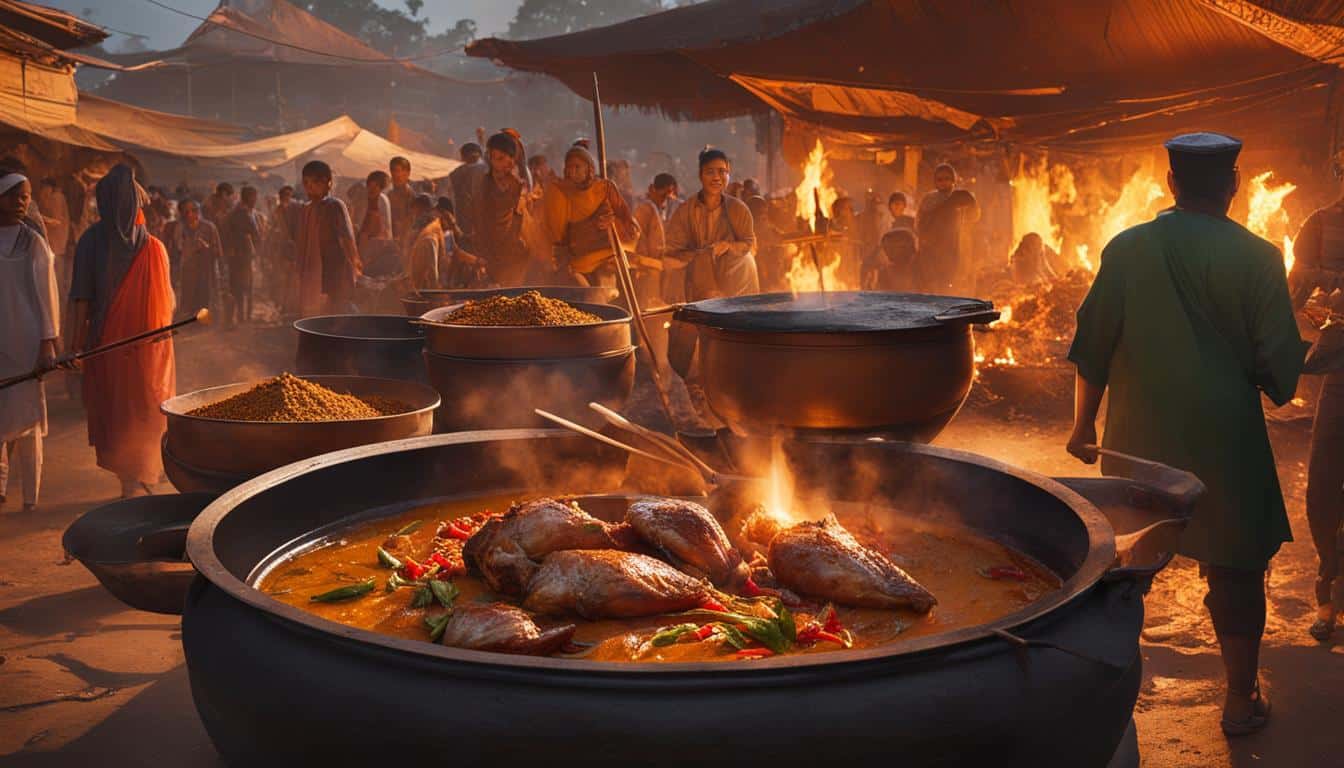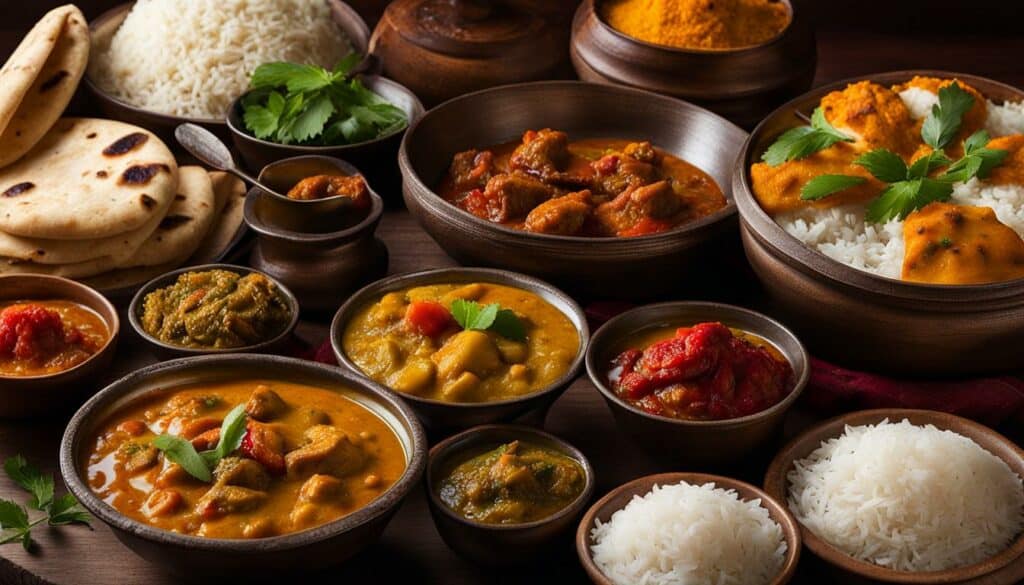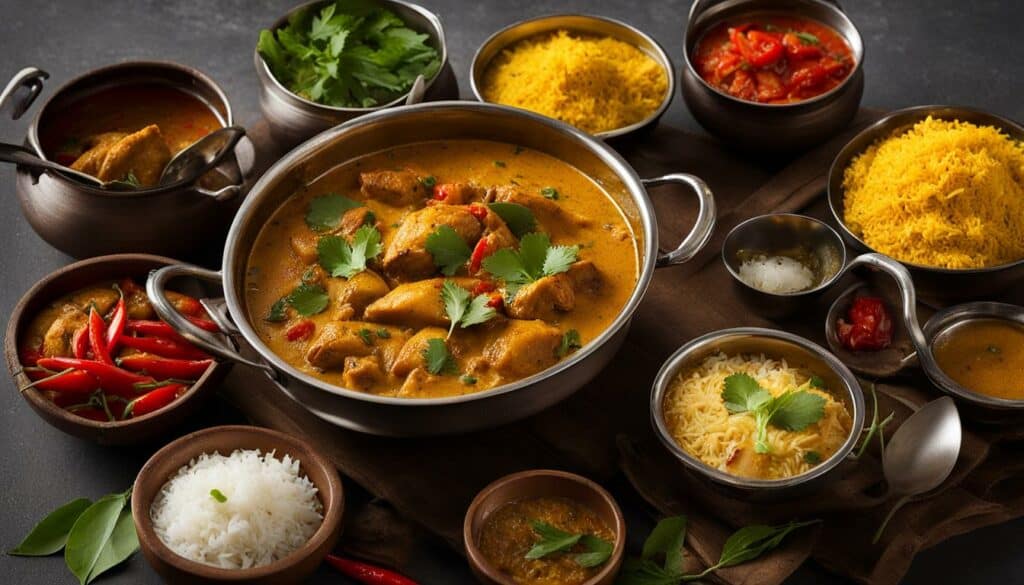
Chicken curry is a beloved dish enjoyed by people all over the world. Its delicious blend of spices, succulent chicken, and flavorful gravy make it a culinary masterpiece. But have you ever wondered where chicken curry originated? Let’s dive into the fascinating history of this iconic dish.
Key Takeaways:
- Chicken curry has its origins in India, specifically in cities like Delhi and Mumbai.
- Indian chicken curry is made with a variety of spices, including garam masala, turmeric, cumin, coriander, red chili powder, ginger, and garlic.
- There are regional variations of chicken curry in India, each offering unique flavors and ingredients.
- Chicken curry is best enjoyed with accompaniments like steamed Basmati rice or naan bread.
- Vegetarian alternatives to chicken curry include paneer and vegetable curries.
A Symphony of Spices: The Heart of Indian Chicken Curry
Indian chicken curry is renowned for its tantalizing blend of spices that create a symphony of flavors. These spices form the very essence of this beloved dish, infusing it with depth, warmth, and a hint of heat. Let’s delve into the key spices that make Indian chicken curry a culinary masterpiece.
The Essential Spices
At the core of Indian chicken curry are a few key spices that are integral to its distinctive taste. Garam masala, a fragrant blend of ground spices such as cardamom, cinnamon, and cloves, imparts a rich and complex flavor profile. Turmeric, known for its vibrant yellow hue, adds earthiness and a touch of bitterness. Cumin provides a warm and nutty flavor, while coriander lends a citrusy and slightly sweet note. Red chili powder, an essential spice, brings the desired heat to the dish.
“The combination of these spices elevates the taste of Indian chicken curry to new heights,” says Chef Aisha Bhatti, a renowned expert in Indian cuisine. “It’s all about achieving the perfect balance between these aromatic ingredients.”
Flavor Enhancers
In addition to the core spices, ginger and garlic are often incorporated into Indian chicken curry to enhance its overall flavor. Ginger adds a zesty and slightly spicy kick, while garlic imparts a pungent and savory note. These two ingredients work harmoniously with the other spices, creating a well-rounded and deeply satisfying taste experience.
Customizing the Spice Blend
While the core spices form the foundation of Indian chicken curry, it’s worth noting that regional variations and personal preferences can influence the spice blend used. Some regions may add fenugreek or mustard seeds for added complexity, while others may opt for fennel or curry leaves to infuse their curry with a unique twist. The beauty of Indian cuisine lies in its adaptability, allowing each cook to tailor the spice blend according to their taste and creativity.
So, the next time you savor the aromatic flavors of Indian chicken curry, take a moment to appreciate the symphony of spices that come together to create this beloved dish. With each bite, you’ll experience the rich heritage and culinary prowess that has made Indian cuisine a global sensation.
The Art of Preparation: A Kaleidoscope of Regional Variations
Indian chicken curry is a dish that showcases the rich culinary diversity of the country. With each region adding its own unique flavors and ingredients, there is a kaleidoscope of regional variations to explore. From the rich and creamy chicken curry of North India to the spicy and tangy flavors of South Indian chicken curry, every region has its own signature style.
In North India, chicken curry is often cooked with a tomato and onion-based gravy that gives it a rich and creamy texture. The flavors are deep and intense, with a perfect balance of spices. The dish is typically enjoyed with naan bread or steamed rice, which helps soak up the delicious gravy.
On the other hand, South Indian chicken curry is known for its bold and fiery flavors. It incorporates ingredients like coconut milk or paste, tamarind, and curry leaves, giving it a distinct tanginess. The gravy is lighter compared to North Indian curry but packs a punch in terms of spiciness. It is often served with steamed rice or dosas, a popular South Indian crepe.
Meanwhile, East Indian chicken curry takes a lighter approach with a focus on simplicity. It uses fewer spices and relies more on the natural flavors of the ingredients. The gravy is light and delicate, allowing the flavors of the chicken and other ingredients to shine through. In contrast, West Indian chicken curry combines sweet and sour flavors by incorporating ingredients like tamarind and jaggery. It creates a unique balance that is both refreshing and satisfying.
Table: Regional Variations of Chicken Curry
| Region | Flavor Profile | Main Ingredients | Serving Suggestions |
|---|---|---|---|
| North India | Rich and creamy | Tomatoes, onions, garam masala | Naan bread, steamed rice |
| South India | Spicy and tangy | Coconut milk, tamarind, curry leaves | Steamed rice, dosas |
| East India | Light and delicate | Mustard seeds, green chilies, curry leaves | Steamed rice, roti |
| West India | Sweet and sour | Tamarind, jaggery, coconut milk | Steamed rice, puri |
Exploring the regional variations of chicken curry is like embarking on a culinary adventure through India. Each region offers a unique take on this beloved dish, showcasing the diverse flavors and cooking techniques that make Indian cuisine so remarkable. Whether you prefer the creamy richness of North Indian curry or the fiery tang of South Indian curry, there is a regional variation to suit every palate.
So the next time you savor a plate of chicken curry, take a moment to appreciate the artistry behind its preparation and savor the flavors that reflect the rich cultural tapestry of India.
Serving and Accompaniments: A Culinary Adventure
When it comes to serving chicken curry, there are a variety of options that elevate the dining experience. The classic combination of steamed Basmati rice and freshly baked naan bread is a perfect accompaniment to the rich and flavorful gravy. The fluffy Basmati rice absorbs the aromatic spices of the curry, while the naan provides a soft and slightly chewy texture.
To add even more depth and variety to the meal, consider serving a side of cucumber raita. This refreshing yogurt-based condiment acts as a cooling counterpart to the spices in the curry, balancing out the flavors and adding a creamy element to each bite. Pickles, such as mango pickle or lime pickle, can also be served to provide a tangy and slightly sour contrast to the richness of the curry.
No Indian meal is complete without crispy papadums. These thin and crispy lentil wafers add a delightful crunch to the meal and can be enjoyed on their own or scooped up with the curry. Their light and airy texture enhances the overall dining experience, making each bite more enjoyable.
Accompaniments for Chicken Curry:
- Steamed Basmati rice
- Freshly baked naan bread
- Cucumber raita
- Pickles (mango pickle, lime pickle, etc.)
- Papadums
| Accompaniment | Description |
|---|---|
| Steamed Basmati rice | Light and fluffy rice that pairs perfectly with the rich curry |
| Freshly baked naan bread | Soft and slightly chewy bread that complements the curry’s flavors |
| Cucumber raita | Cooling yogurt-based condiment that adds creaminess and balances the spices |
| Pickles | Tangy and sour condiments that provide a contrast to the rich curry |
| Papadums | Crispy lentil wafers that add a delightful crunch to the meal |
With these accompaniments, each bite of chicken curry becomes a culinary adventure, combining different textures, flavors, and temperatures. The interplay between the rich and flavorful curry, the aromatic rice, the soft bread, the cooling raita, the tangy pickles, and the crispy papadums creates a truly memorable dining experience.

Vegetarian Twist: Paneer and Vegetable Curries
For those seeking a meatless option or simply wanting to explore further, vegetarian curries provide delicious alternatives to traditional chicken curry. Paneer curry and vegetable curry are two popular choices that offer a delightful array of flavors and textures.
Paneer Curry:
Paneer curry is a vegetarian dish that features paneer, a type of Indian cottage cheese, as the star ingredient. The paneer is cooked in a rich and creamy tomato-based gravy that is infused with aromatic spices. This curry provides a satisfying and protein-rich option for vegetarians, and its creamy texture pairs perfectly with steamed rice or naan bread.
“Paneer curry is a perfect blend of creamy and tangy flavors. The softness of paneer and the richness of the gravy make it a truly indulgent dish.” – Indian Food Blogger
Vegetable Curry:
Vegetable curry is a versatile dish that allows for endless creativity. It can be made with a variety of vegetables such as potatoes, cauliflower, peas, carrots, and bell peppers. The vegetables are cooked in a flavorful sauce made with spices, onions, tomatoes, and sometimes coconut milk. This curry is not only delicious but also packed with nutrients, making it a wholesome option for a vegetarian meal.
“Vegetable curry is a healthy and hearty dish that showcases the vibrant colors and flavors of fresh vegetables. It’s a great way to incorporate more vegetables into your diet while enjoying a delicious curry.” – Food Enthusiast
Both paneer curry and vegetable curry offer a wide range of possibilities for customization. You can adjust the spice level to suit your taste preferences and experiment with different combinations of vegetables and spices. These vegetarian curries provide a delightful twist on traditional chicken curry and are sure to satisfy even the most discerning palate.
| Curry | Main Ingredients | Flavor Profile |
|---|---|---|
| Paneer Curry | Paneer (Indian cottage cheese), tomatoes, spices | Creamy, tangy |
| Vegetable Curry | Assorted vegetables, onions, tomatoes, spices | Varies based on vegetables used |
South Indian Chicken Curry Recipe
Experience the authentic flavors of South India with this mouthwatering chicken curry recipe. Made with a blend of aromatic spices and cooked to perfection, it is a dish that will delight your taste buds. Gather the following ingredients to create this delectable South Indian chicken curry:
- 500 grams of chicken, cut into pieces
- 2 tablespoons of vegetable oil
- 2 onions, finely chopped
- 3 tomatoes, pureed
- 2 teaspoons of ginger-garlic paste
- 1 teaspoon of turmeric powder
- 1 tablespoon of red chili powder
- 1 tablespoon of coriander powder
- 1 teaspoon of cumin powder
- 1 teaspoon of garam masala
- Salt to taste
- Fresh coriander leaves for garnishing
To begin, heat the oil in a pan over medium heat. Add the chopped onions and sauté until they turn golden brown. Next, add the ginger-garlic paste and cook for a minute until the raw aroma disappears. Now, it’s time to add the tomato puree and cook until the oil separates from the mixture.
Add the turmeric powder, red chili powder, coriander powder, cumin powder, and garam masala to the pan. Mix well and cook for a couple of minutes to allow the flavors to meld together. Now, add the chicken pieces and season with salt. Coat the chicken with the spice mixture and let it cook for a few minutes until it is sealed.
Reduce the heat to low, cover the pan, and let the chicken simmer for about 20-25 minutes. Stir occasionally to ensure that the chicken is evenly cooked. Once the chicken is tender and cooked through, garnish with fresh coriander leaves.
Now you can enjoy the authentic taste of South Indian chicken curry. Serve it with steamed rice or hot dosas for a complete and satisfying meal.

Conclusion
Chicken curry, a dish that originated in India, has become a beloved favorite around the world. Its rich history and diverse flavors showcase the culinary diversity of Indian cuisine. From the aromatic spices to the regional variations, chicken curry offers a delightful sensory experience that captivates food enthusiasts.
With its origins deeply rooted in Indian cuisine, chicken curry represents the essence of this flavorful and vibrant culinary tradition. The harmonious blend of spices, tender chicken, and rich gravy reflects the artistry and expertise of Indian chefs. It is no wonder that this dish has gained popularity globally and is enjoyed by people of all backgrounds and tastes.
Indian cuisine, with its extensive range of flavors and ingredients, is a testament to the culinary diversity of the country. Chicken curry, with its origins in India, stands as a shining example of the vibrant and varied dishes that can be found within Indian cooking. From the bustling streets of Delhi to the cozy kitchens of Mumbai, chicken curry continues to bring people together and delight their taste buds.
Whether you’re savoring a classic chicken curry or exploring vegetarian alternatives like paneer curry or vegetable curry, the flavors and aromas of Indian cuisine are sure to leave a lasting impression. So, next time you indulge in a steaming plate of chicken curry, take a moment to appreciate its origins, the rich tapestry of Indian cuisine, and the culinary diversity it represents.
https://vauro.net/food-drink/lion-head-clear-soup/
FAQ
Where did chicken curry originate?
Chicken curry originated in India, specifically in the bustling streets of Delhi and the cozy kitchens of Mumbai.
What spices are commonly used in Indian chicken curry?
Common spices used in Indian chicken curry include garam masala, turmeric, cumin, coriander, red chili powder, ginger, and garlic.
What are the regional variations of chicken curry in India?
In North India, chicken curry is rich and creamy with a tomato and onion-based gravy. South Indian chicken curry is spicy and tangy, often made with coconut milk. East Indian chicken curry is lighter and less creamy, while West Indian chicken curry incorporates ingredients like tamarind and jaggery for a sweet and sour balance.
What are the best accompaniments for chicken curry?
Chicken curry is best enjoyed with steamed Basmati rice or freshly baked naan bread. Side dishes like cucumber raita, pickles, and papadum can also be served alongside the curry to add variety and texture to the meal.
Is there a vegetarian alternative to chicken curry?
Yes, paneer (Indian cottage cheese) and vegetable curries offer delightful alternatives to chicken curry. These dishes incorporate similar preparation methods and spice combinations, providing equally satisfying options for any palate.
Can you share a recipe for South Indian chicken curry?
Certainly! A traditional South Indian chicken curry recipe involves marinating the chicken with a blend of spices, then cooking it in a sauce made with onions, tomatoes, and a spice paste. The curry is simmered until the chicken is tender and the flavors meld together. It is best served with steamed rice or hot dosas for a complete and satisfying meal.
